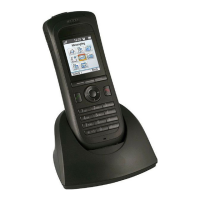TD 92930EN
13 December 2013 /Ver B
Configuration Manual
WL3 and WL3 Plus WLAN Handset
52
6. Handset Configuration
expires. In addition, if a message is not shown again within the TTR interval, it is
considered as not important and is removed from the queue.
Figure 6. Message handling without manually closing a message.
In figure 6, a message with prio 2 is received and displayed in the handset. TTP and
TTR for the message is started.
After 10 seconds, a second message with priority 1 is received and displayed while the
message with priority 2 is put in the queue. TTP for the message with priority 2 is
paused, but TTR continues. TTP and TTR for the message with priority 1 is started.
After 20 seconds, TTP expires but TTR continues for the message with prio 1 and the
message is placed in the queue. The message with priority 2 is shown again and its
TTP continues.
TTP expires after 10 seconds but TTR continues for the message with priority 2. In this
case, all messages have been shown 20 seconds each, and the oldest shown
message with the highest priority is displayed (in this case, the message with priority
1). The handset does not indicate when it shows the message again, since it already
has been shown and indicated once. The message with priority 2 is placed in the
queue.
After 80 seconds, the TTR expires for the message with priority 2, and it is removed
from the queue and is indicated as an unread message in the Messaging Inbox. When
TTR expires for the message with priority 1, it is also indicated as an unread message
in the Messaging Inbox.
NOTE: If no messages have been read/closed manually and TTP expired for each
message, a dialog window New message(s): [number of messages]. View now?
is displayed. All messages are indicated as unread messages in the Messaging
Inbox.
Example 4
This example describes the message handling with the following message settings:
• TTP= No prioritization
• TTR= Close manually

